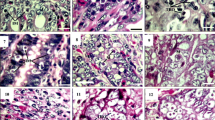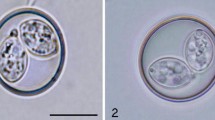Abstract
Approximately 14 of the more than 1,000 species of microsporidia infect humans, only two of which, Enterocytozoon bieneusi and Encephalitozoon intestinalis, cause intestinal microsporidiosis. Clinical isolates of three microsporidia species, E. intestinalis, Encephalitozoon hellem, and the insect parasite, Anncaliia (Brachiola, Nosema) algerae were used in a spore germination assay, and enterocyte attachment and infection assays were performed to model the potential roles of gastric and duodenal environments and host temperature in determining why only one of these microsporidia species causes intestinal microsporidiosis. Enterocyte infection with A. algerae spores was 10% that of the Encephalitozoon species, a difference not attributable to differences in spore attachment to host cells. Prior spore treatment with pepsin in HCl, pancreatic enzymes, or ox bile did not inhibit germination or enterocyte infection by the three microsporidia species. While the Encephalitozoon species differentiated to mature spores within 3 days, the time taken for many enterocytes to turn over, A. algerae took 3–5 days to produce mature spores, near the upper limit for enterocyte turnover in vivo. Thus, host temperature may contribute to A. algerae not causing human intestinal microsporidiosis, but none of the factors tested account for the inability of E. hellem to cause such an infection.





Similar content being viewed by others
References
Avery SW, Undeen AH (1987) The isolation of microsporidia and other pathogens from concentrated ditch water. J Am Mosq Control Assoc 3:54–58
Cotte L, Rabodonirina M, Chapuis F, Bailly F, Bissuel F, Raynal C, Gelas P, Persat F, Piens M-A, Trepo C (1999) Waterborne outbreak of intestinal microsporidiosis in persons with and without human immunodeficiency virus infection. J Infect Dis 180:2003–2008
Couzinet S, Cejas E, Schittny J, Deplazes P, Weber R, Zimmerli S (2000) Phagocytic uptake of Encephalitozoon cuniculi by nonprofessional phagocytes. Infect Immun 68:6939–6945
Coyle CM, Weiss LM, Rhodes LV, Cali A, Takvorian PM, Brown DF, Visvesvara GS, Xiao L, Naktin J, Young E, Gareca M, Colasante G, Wittner M (2004) Fatal myositis due to the microsporidia Brachiola algerae, a mosquito pathogen. N Engl J Med 351:42–47
Didier ES (2005) Microsporidiosis: an emerging and opportunistic infection in humans and animals. Acta Trop 94:61–76
Didier ES, Orenstein JM, Aldras A, Bertucci D, Rogers LB, Janney FA (1995) Comparison of three staining methods for detecting microsporidia in fluids. J Clin Microbiol 33:3138–3145
Dowd SE, Gerba CP, Pepper IL (1998) Confirmation of human-pathogenic microsporidia Enterocytozoon bieneusi, Encephalitozoon intestinalis, and Vittaforma corneae in water. Appl Environ Microbiol 64:3332–3335
Franzen C (2004) Microsporidia: how can they invade other cells? Trends Parasitol 20:275–279
Franzen C, Hosl M, Salzberger B, Hartmann P (2005) Uptake of Encephalitozoon spp. and Vittaforma corneae (microsporidia) by different cells. J Parasitol 91:745–749
Franzen C, Nassanova ES, Scholmerich J, Issi IV (2006) Transfer of the members of the genus Brachiola (Microsporidia) to the genus Anncaliia based on ultrastructural and molecular data. J Eukaryot Microbiol 53:26–35
Frixione E, Ruiz L, Cerbon J, Undeen AH (1997) Germination of Nosema algerae (Microspora) spores: conditional inhibition by D2O, ethanol and Hg2+ suggests dependence of water influx upon membrane hydration and specific transmembrane pathways. J Eukaryot Microbiol 44:109–116
Graczyk TK, Conn DB, Lucy F, Minchin D, Tamang L, Moura LN, DaSilva AJ (2004) Human waterborne parasites in zebra mussels (Dreissena polymorpha) from the Shannon River drainage area, Ireland. Parasitol Res 93:385–391
Graczyk TK, Majewska AC, Schwab KJ (2008) The role of birds in dissemination of human waterborne enteropathogens. Trends Parasitol 24:55–59
Hayman JR, Southern TR, Nash TE (2005) Role of sulfated glycans in adherence of the microsporidian Encephalitozoon intestinalis to host cells in vitro. Infect Immun 73:841–848
Jones BA, Gore GJ (1997) Physiology and pathophysiology of apoptosis in epithelial cells of the liver, pancreas and intestine. Am J Physiol 273:G1174–G1188
Kotler DP, Orenstein JM (1998) Clinical syndromes associated with microsporidiosis. Adv Parasitol 40:321–341
Koudela B, Visvesvara GS, Moura H, Vavra J (2001) The human isolate of Brachiola algerae (Phylum Microsporidia): development in SCID mice and description of its fine structure features. Parasitology 123:153–162
Kucerova Z, Moura H, Visvesvara GS, Leitch GJ (2004) Differences between Brachiola (Nosema) algerae isolates of human and insect origin when tested using an in vitro spore germination assay and a cultured cell infection assay. J Eukaryot Microbiol 51:339–343
Kwakye-Nuako G, Borkettey P, Mansah-Attipoe I, Asmah R, Ayeh-Kumi P (2007) Sachet drinking water in Accra: the potential threats of transmission of enteric pathogenic protozoan organisms. Ghana Med J 41:62–67
Leitch GJ, He Q, Wallace S, Visvesvara GS (1993) Inhibition of the spore polar filament extrusion of the microsporidium, Encephalitozoon hellem, isolated from an AIDS patient. J Eukaryot Microbiol 40:711–717
Leitch GJ, Ward TL, Shaw AP, Newman G (2005) Apical spore phagocytosis is not a significant route of infection of differentiated enterocytes by Encephalitozoon intestinalis. Infect Immun 73:7697–7704
Lipkin M (1987) Proliferation and differentiation of normal and diseased gastrointestinal cells. In: Johnson LR (ed) Physiology of the gastrointestinal tract. Raven, New York, NY, pp 255–284
Lowman PM, Takvorian PM, Cali A (2000) The effects of elevated temperature and various time-temperature combinations on the development of Brachiola (Nosema) algerae N. Comb. in mammalian cell culture. J Eukaryot Microbiol 47:221–234
Mathis A, Weber R, Deplazes P (2005) Zoonotic potential of the microsporidia. Clin Microbiol Rev 18:423–445
Moura H, da Silva AJ, Moura IN, Schwartz DA, Leitch GJ, Wallace S, Pieniazek NJ, Wirtz RA, Visvesvara GS (1999) Characterization of Nosema algerae isolates after continuous cultivation in mammalian cells at 37°C. J Eukaryot Microbiol 46:14S–16S
Muller A, Bialek R, Kamper A, Fatkenheuer G, Salzberger B, Franzen C (2001) Detection of microsporidia in travelers with diarrhea. J Clin Microbiol 39:1630–1632
Southern TR, Jolly CE, Lester ME, Hayman JR (2007) EnP1, a microsporidian spore wall protein that enables spores to adhere to and infect host cells in vitro. Eukaryotic Cell 6:1354–1362
Trammer T, Dumbrowski F, Doehring M, Maier WA, Seitz HM (1997) Opportunistic properties of Nosema algerae (Microspora), a mosquito parasite, in immunocompromised mice. J Eukaryot Microbiol 44:258–262
Undeen AH (1975) Growth of Nosema algerae in pig kidney cell culture. J Protozool 22:107–110
Undeen AH, Alger N (1976) Nosema algerae: infection of the white mouse by a mosquito parasite. Exp Parasitol 40:86–88
Visvesvara GS, Leitch GJ, Moura H, Wallace S, Weber R, Bryan RT (1991) Culture, electron microscopy, and immunoblot studies on a microsporidian isolated from the urine of a patient with AIDS. J Protozool 38:105S–111S
Visvesvara GS, Moura H, Leitch GJ, Schwartz DA (1999) Culture and propagation of microsporidia. In: Whittner M, Weiss LM (eds) The microsporidia and microsporidiosis. ASM, Washington, DC, pp 363–392
Visvesvara GS, Moura H, Leitch GJ, Schwartz DA, Xiao LX (2005) Public health importance of Brachiola algerae (Microsporidia)—an emerging pathogen of humans. Folia Parasitol (Praha) 52:83–94
Wasson K, Barry PA (2003) Molecular characterization of Encephalitozoon intestinalis (Microsporidia) replication kinetics in a murine intestinal cell line. J Eukaryot Microbiol 50:169–174
Acknowledgments
This work was supported by US PHS grant R21 DK64573.
Author information
Authors and Affiliations
Corresponding author
Rights and permissions
About this article
Cite this article
Leitch, G.J., Ceballos, C. Effects of host temperature and gastric and duodenal environments on microsporidia spore germination and infectivity of intestinal epithelial cells. Parasitol Res 104, 35–42 (2008). https://doi.org/10.1007/s00436-008-1156-4
Received:
Accepted:
Published:
Issue Date:
DOI: https://doi.org/10.1007/s00436-008-1156-4




